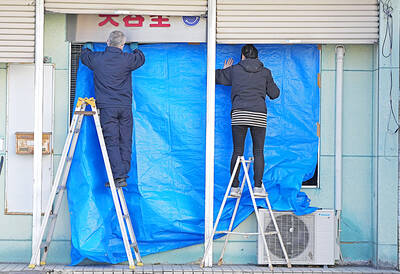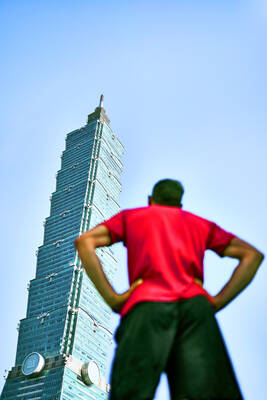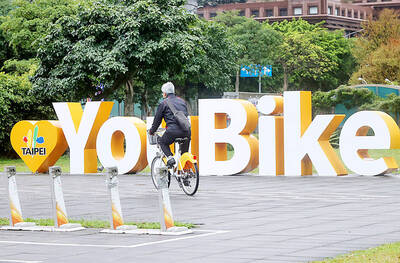Although the government is aiming for the Fourth Nuclear Power Plant to start commercial operations by 2015, this could be delayed to 2018 or even 2020 if the Atomic Energy Council (AEC) pushes its demand that Taiwan Power Co conclude its safety research prior to installing fuel rods, the Yenliao Anti-Nuclear Self-Help Association said.
Association secretary-general Yang Mu-huo (楊木火) said he had sent a letter to the council last year expressing his concern about safety measures at the nuclear power plant, currently undergoing construction in Gongliao District (貢寮), New Taipei City (新北市), in the event of an earthquake or tsunami.
The council responded in a letter that it would ask Taipower to conduct a study on the effect on an earthquake or floods on the three operational nuclear power plants, using the standards and regulations laid down by the US Atomic Energy Commission, and that the research should be completed before Taipower could start installing fuel rods into the Fourth Nuclear Power Plant’s reactors, Yang said.
However, the council disputes Yang’s claims.
In a press conference on Feb. 23, AEC vice chairman Chou Yuan-ching (周源卿) said the council had asked Taipower to conduct research on ancient tsunami deposits around the Fourth Nuclear Power Plant site, but “the research was not made a prerequisite to the installation of fuel rods into the reactors.”
Yang said Chou’s comments contradicted the information that he received from the council.
“The letter [from the council] said that the research would also include historic tsunamis and that the research would be concluded by the end of March this year,” Yang said.
However, Taipower has yet to commission any groups for the research and analysis, he added.
Although the National Science Council conducted research in 2011 on how tsunamis might affect Taiwan, it was a rough analysis based on data from submarine faults and did not include an analysis of statistics relating to historic tsunamis, Yang said.
The Yaeyama tsunami that occurred near the Ryuku Islands in 1771 and the Keelung tsunami in 1876 showed that tsunamis pose a threat to Taiwan, Yang said.
Every day that the research is delayed, doubts about nuclear safety will persist, Yang said, adding that the government should pressure Taipower to start the research as soon as possible.
It would take two or three years to complete the study, and there are potential difficulties, such as a lack of experts to conduct this type of research, Yang said.
Such a study also requires researchers to drill samples from rocks around the plant site.
Researchers will also have to obtain authorization from nearby landowners, which could slow completion of the study, he said.
Yang also cited a report by the Ministry of Economic Affairs to the legislature on Jan. 10, in which it said that the tsunami barrier Taipower was building for the Fourth Nuclear Power Plant was only 2m high.
The 2m wall, added to the 12m height of the land on which the plant is situated, means the plant would only be able to shield itself — barely — from a 14m tidal wave, Yang said, adding that the tsunami 200 years ago was 24.8m high.
The current plans are not sufficient to offer protection against a tsunami of that magnitude, Yang said.

Taiwanese were praised for their composure after a video filmed by Taiwanese tourists capturing the moment a magnitude 7.5 earthquake struck Japan’s Aomori Prefecture went viral on social media. The video shows a hotel room shaking violently amid Monday’s quake, with objects falling to the ground. Two Taiwanese began filming with their mobile phones, while two others held the sides of a TV to prevent it from falling. When the shaking stopped, the pair calmly took down the TV and laid it flat on a tatami mat, the video shows. The video also captured the group talking about the safety of their companions bathing

US climber Alex Honnold is to attempt to scale Taipei 101 without a rope and harness in a live Netflix special on Jan. 24, the streaming platform announced on Wednesday. Accounting for the time difference, the two-hour broadcast of Honnold’s climb, called Skyscraper Live, is to air on Jan. 23 in the US, Netflix said in a statement. Honnold, 40, was the first person ever to free solo climb the 900m El Capitan rock formation in Yosemite National Park — a feat that was recorded and later made into the 2018 documentary film Free Solo. Netflix previewed Skyscraper Live in October, after videos

Starting on Jan. 1, YouBike riders must have insurance to use the service, and a six-month trial of NT$5 coupons under certain conditions would be implemented to balance bike shortages, a joint statement from transportation departments across Taipei, New Taipei City and Taoyuan announced yesterday. The rental bike system operator said that coupons would be offered to riders to rent bikes from full stations, for riders who take out an electric-assisted bike from a full station, and for riders who return a bike to an empty station. All riders with YouBike accounts are automatically eligible for the program, and each membership account

A classified Pentagon-produced, multiyear assessment — the Overmatch brief — highlighted unreported Chinese capabilities to destroy US military assets and identified US supply chain choke points, painting a disturbing picture of waning US military might, a New York Times editorial published on Monday said. US Secretary of Defense Pete Hegseth’s comments in November last year that “we lose every time” in Pentagon-conducted war games pitting the US against China further highlighted the uncertainty about the US’ capability to intervene in the event of a Chinese invasion of Taiwan. “It shows the Pentagon’s overreliance on expensive, vulnerable weapons as adversaries field cheap, technologically